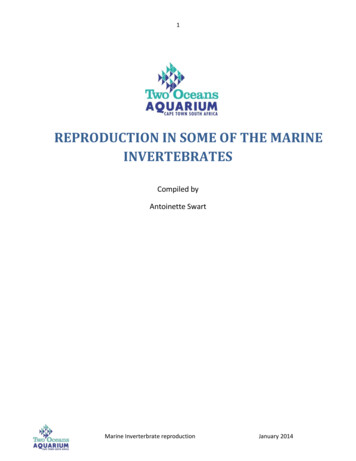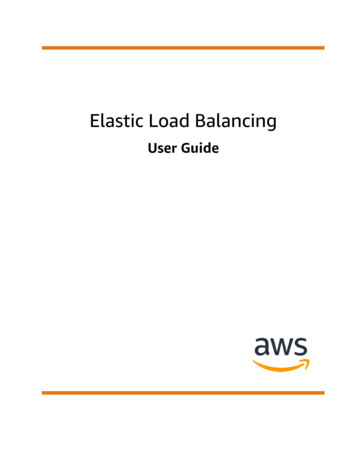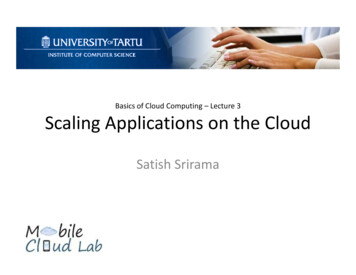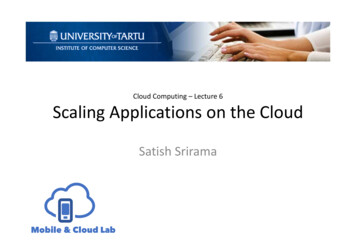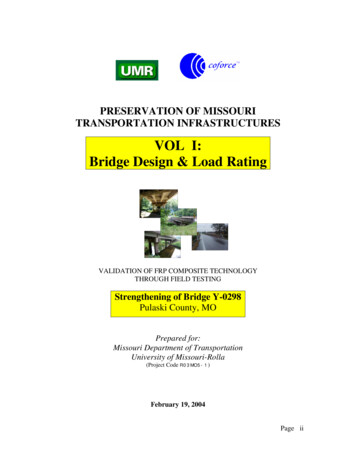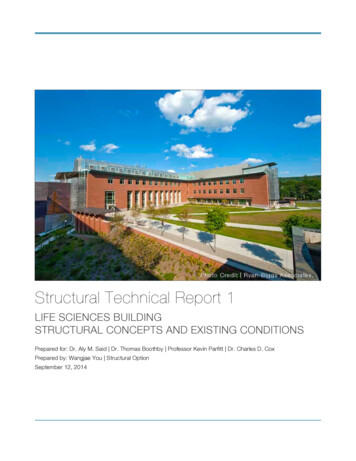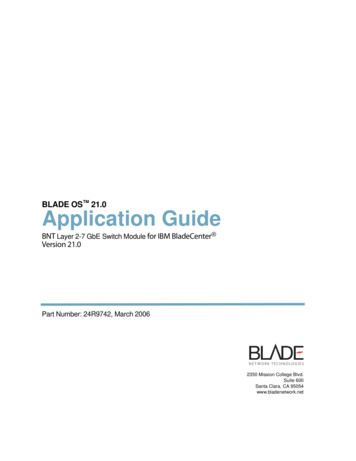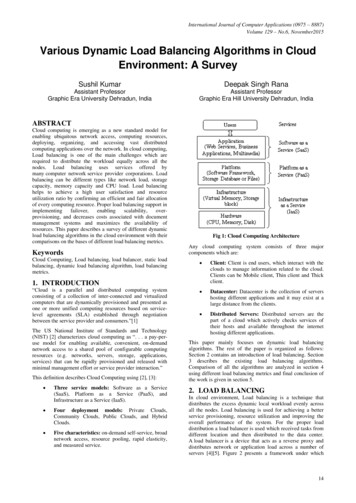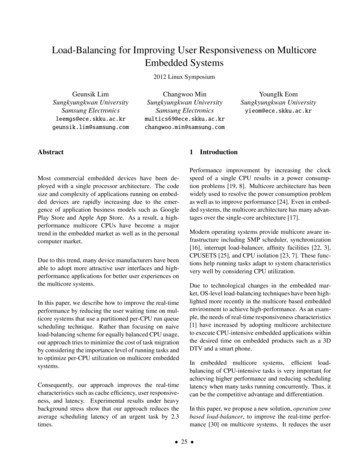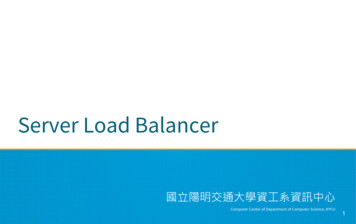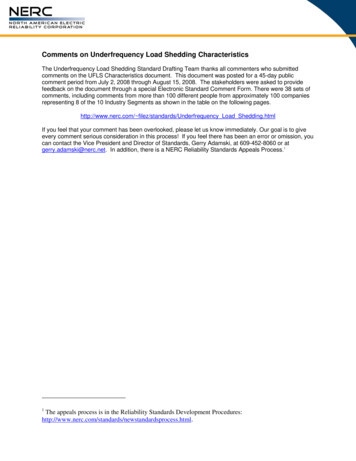
Transcription
Comments on Underfrequency Load Shedding CharacteristicsThe Underfrequency Load Shedding Standard Drafting Team thanks all commenters who submittedcomments on the UFLS Characteristics document. This document was posted for a 45-day publiccomment period from July 2, 2008 through August 15, 2008. The stakeholders were asked to providefeedback on the document through a special Electronic Standard Comment Form. There were 38 sets ofcomments, including comments from more than 100 different people from approximately 100 companiesrepresenting 8 of the 10 Industry Segments as shown in the table on the following pages.http://www.nerc.com/ filez/standards/Underfrequency Load Shedding.htmlIf you feel that your comment has been overlooked, please let us know immediately. Our goal is to giveevery comment serious consideration in this process! If you feel there has been an error or omission, youcan contact the Vice President and Director of Standards, Gerry Adamski, at 609-452-8060 or atgerry.adamski@nerc.net. In addition, there is a NERC Reliability Standards Appeals Process.11The appeals process is in the Reliability Standards Development rdsprocess.html.
Comments on Underfrequency Load Shedding Characteristics— Project 2008-05Index to Questions, Comments, and Responses1.2.3.4.5.6.7.8.9.The SDT determined that there is no need to have a continent-wide standard, and proposes that allUFLS requirements be contained within the regional UFLS standards developed in accordance withthe Characteristics of UFLS Regional Reliability Standards. The SDT developed a set ofcharacteristics which each of the regional entities will be directed to include in its UFLS regionalreliability standard. The SDT developed these characteristics in an attempt to direct the regionalentities to develop requirements based on system performance, without prescribing specifics of howto meet the specified performance. Do you agree with the drafting team?. 3As proposed, each regional UFLS standard must require that, for underfrequency conditionsresulting from an imbalance between load and generation of at least 25 percent within aninterconnection, region, or identified island(s) within or between regions, the UFLS must arrestfrequency decline at no less than 58.0 Hz. Do you agree with this design parameter? If youdisagree, please identify whether you believe this design parameter should be deleted or revised. 17As proposed, each regional UFLS standard must require that, for underfrequency conditionsresulting from an imbalance between load and generation of at least 25 percent within aninterconnection, region, or identified island(s) within or between regions, the UFLS must act suchthat frequency does not remain below 58.5 Hz for greater than 10 seconds, cumulatively, andfrequency does not remain below 59.5 Hz for greater than 30 seconds, cumulatively. Do you agreewith this design parameter? If you disagree, please identify whether you believe this designparameter should be deleted or revised. 22As proposed, each regional UFLS standard must require that, for underfrequency conditionsresulting from an imbalance between load and generation of at least 25 percent within aninterconnection, region, or identified island(s) within or between regions, the UFLS must act suchthat the frequency overshoot resulting from operation of UFLS relays will not exceed 61.0 Hz for anyduration and will not exceed 60.5 Hz for greater than 30 seconds, cumulatively. Do you agree withthis design parameter? If you disagree, please identify whether you believe this design parametershould be deleted or revised. . 29As proposed, each regional UFLS standard must require that, for underfrequency conditionsresulting from an imbalance between load and generation of at least 25 percent within aninterconnection, region, or identified island(s) within or between regions, the UFLS must act suchthat the Bulk Electric System voltage during and following UFLS operations is controlled such thatthe per unit Volts per Hz (V/Hz) does not exceed 1.18 for longer than 6 seconds cumulatively, anddoes not exceed 1.10 for longer than 1 minute cumulatively. Do you agree with this designparameter? If you disagree, please identify whether you believe this design parameter should bedeleted or revised. . 35If there are any other characteristics in the UFLS Regional Reliability Standard Characteristicsdocument that you disagree with, please identify them here, and either identify that they should bedeleted, or recommend an alternative. 41The SDT proposes that the regional standards include the database requirements contained inexisting Reliability Standard PRC-007. Do you agree that database requirements should beaddressed within the Regional Standards?. 49Are you aware of any conflicts between the proposed regional standards and any regulatoryfunction, rule, order, tariff, rate schedule, legislative requirement, or agreement?. 53Do you have any other questions or concerns with the proposed Under Frequency Load SheddingRegional Reliability Standard Characteristics that have not been addressed? If yes, please explain.562
Comments on Underfrequency Load Shedding Characteristics— Project 2008-05The Industry Segments are:1 — Transmission Owners2 — RTOs, ISOs3 — Load-serving Entities4 — Transmission-dependent Utilities5 — Electric Generators6 — Electricity Brokers, Aggregators, and Marketers7 — Large Electricity End Users8 — Small Electricity End Users9 — Federal, State, Provincial Regulatory or other Government Entities10 – Regional Reliability Organizations, Regional Entities1.2.Individualor group.IndividualNameOrganizationKarl KohlrusGroupGuy ZitoCity Water, Light &Power - Springfield, ILNPCCRegionRegistered Ballot body segment (check all industry segments in which your company isregistered)1 - Transmission Owners, 3 - Load-serving Entities, 5 - Electric Generators10 - Regional Reliability Organizations/Regional EntitiesAdditional MemberAdditionalOrganizationSegmentSelection1.Ed ThompsonConsolidated Edison Co. NPCCof New York, Inc.12.David KiguelHydro One Networks Inc. NPCC13.Sylvain ClermontHydro-QuebecTransEnergieNPCC14.Frederick WhiteNortheast UtilitiesNPCC15.Roger ChampagneHydro-QuebecTransEnergieNPCC26.Ron FalsettiIndependent ElectricitySystem OperatorNPCC27.Kathleen GoodmanISO - New EnglandNPCC23
Comments on Underfrequency Load Shedding Characteristics— Project 2008-05Individualor group.NameOrganizationRegistered Ballot body segment (check all industry segments in which your company isregistered)8.Randy MacDonaldNew Brunswick SystemOperatorNPCC29.Gregory CampoliNew York IndependentSystem OperatorNPCC210. Michael RanalliNational GridNPCC311. Ronald E. HartDominion Resources,Inc.NPCC512. Ralph RufranoNew York PowerAuthorityNPCC513. Brian L. GooderOntario PowerNPCCGeneration Incorporated514. Michael GildeaConstellation EnergyNPCC615. Brian D. EvansMongeonUtility ServicesNPCC616. Donald E. NelsonMassachusetts Dept. ofPublic UtilitiesNPCC917. Brian HogueNPCCNPCC1018. Alan AdamsonNew York StateReliability CouncilNPCC1019. Guy ZitoNPCCNPCC1020. Lee PedowiczNPCCNPCC1021. Gerry DunbarNPCCNPCC103.IndividualEdwin Averill4.5.GroupIndividualKen McIntyreDon McInnisGrand River DamAuthorityERCOTFlorida Power & Light5 - Electric Generators, 1 - Transmission Owners, 9 - Federal, State, Provincial Regulatory, or otherGovernment Entities2 - RTOs and ISOs1 - Transmission Owners4
Comments on Underfrequency Load Shedding Characteristics— Project 2008-05NameOrganization6.Individualor group.IndividualVic. BaergManitoba Hydro7.IndividualThad Ness8.GroupAnnetteBannonAmerican Electric Power(AEP)PPL GenerationAdditional Member Additional Organization1.Mark HeimbachRegistered Ballot body segment (check all industry segments in which your company isregistered)1 - Transmission Owners, 5 - Electric Generators, 3 - Load-serving Entities, 9 - Federal, State,Provincial Regulatory, or other Government Entities, 6 - Electricity Brokers, Aggregators6 - Electricity Brokers, Aggregators , 3 - Load-serving Entities, 5 - Electric Generators, 1 Transmission Owners1 - Transmission Owners, 5 - Electric Generators, 6 - Electricity Brokers, AggregatorsRegionSegmentSelectionMRO62.PPL EnergyPlusNPCC63.RFC64.SERC65.SPP66.John CummingsPPL EnergyPlusWECC67.Joe KiselaPPL GenerationRFC5NPCC58.9.Tom LehmanPPL MontanaWECC510.Dave GladeyPPL SusquehannaRFC511.Mike DeCesarisPPL Electric Utilities RFC112.Gabe LaczoPPL Electric Utilities RFC113.Gary BastPPL Electric Utilities RFC114.Dave PricePPL Electric Utilities RFC19.GroupLynnSchroederSouthwest Power Pool(SPP UFLS Standard10.GroupBrian BartosBandera ElectricCooperative (TRE10 - Regional Reliability Organizations/Regional EntitiesDrafting Team)1 - Transmission OwnersRegional UFLS StandardDrafting Team)Additional Member Additional OrganizationRegionSegmentSelection1.Dennis KunkelAEPERCOT12.Randy JonesCalpineERCOT55
Comments on Underfrequency Load Shedding Characteristics— Project 2008-05Individualor group.NameOrganizationRegistered Ballot body segment (check all industry segments in which your company isregistered)3.Matt PawlowskiFPL EnergyERCOT54.Rayborn ReaderEPCOERCOT75.Eddy ReeceRayburn Country ERCOT16.Barry KremlingGVECERCOT17.Sergio GarzaLCRAERCOT18.Steve MyersERCOT ISOERCOT29.Ken McIntryreERCOT ISOERCOT211.Individual12.Individual13.GroupO. J.BrouilletteSteveHarmathMarie KnoxLouisiana Generqting,LLCOrrville Utilities3 - Load-serving Entities, 5 - Electric Generators, 4 - Transmission-dependent Utilities, 1 Transmission Owners4 - Transmission-dependent UtilitiesMidwest ISO2 - RTOs and ISOsAdditional Member Additional OrganizationRegionSegmentSelection1.Kirit ShahAmeren2.Jim CyrulewskiJDRJC Associates RFC14.GroupJim BusbinSERCSouthern CompanyServices, IncAdditional Member Additional OrganizationRegion185 - Electric Generators, 1 - Transmission OwnersSegmentSelection1.Chris WilsonSouthern Company Services SERC12.Terry CogginsSouthern Company Services SERC13.Jonathan GlidewellSouthern Company Services SERC14.Raymond ViceSouthern Company Services SERC15.J. T. WoodSouthern Company Services SERC16.Terry CrawleySouthern Company Services SERC57.Marc ButtsSouthern Company Services SERC115.16.IndividualGroupAdditional Member1.Mark KurasPeter HeidrichPJMFlorida ReliabilityCoordinating CouncilAdditional OrganizationJerry Murphy2 - RTOs and ISOs1 - Transmission Owners, 4 - Transmission-dependent Utilities, 3 - Load-serving Entities, 10 Regional Reliability Organizations/Regional Entities, 5 - Electric GeneratorsRegionSegmentSelectionReedy Creek Improvement District FRCC36
Comments on Underfrequency Load Shedding Characteristics— Project 2008-05Individualor group.NameOrganizationRegistered Ballot body segment (check all industry segments in which your company isregistered)2.John ShafferFlorida Power & LightFRCC13.John OdomFRCCFRCC104.Fabio RodriguezProgress EnergyFRCC15.Don GIlbertJEAFRCC56.Alan GaleCity of TallahasseeFRCC57.Don McInnisFlorida Power & LightFRCC18.Art NordlingerTampa Electric CompanyFRCC19.FRCC System Protection & Control Subcommittee FRCCFRCC1017.GroupBob JonesSouthern CompanyServices, Inc. - TransAdditional Member Additional Organization1 - Transmission OwnersRegionSegmentSelection1.Rick FosterAmerenSERC12.Anthony WilliamsDuke Energy CarolinasSERC13.Greg DavisGeorgia Transmission Corp.SERC14.Ernesto PaonMunicipal Electric Authority of GeorgiaSERC15.Andrew FuscoNC Municipal Power Agency #1SERC16.John O'ConnorProgress Energy CarolinasSERC17.Pat HuntleySERC Reliability Corp.SERC108.Jonathan GlidewellSouthern Company Services, Inc. - Trans SERC19.Tom CainTennessee Valley dualGroupKevin KoloiniRick WhiteHoward RulfJohn WShafferEricMortensonD. Bryan GuyKirit ShahKenGoldsmithSERCBuckeye Power, Inc.Northeast UtilitiesWe EnergiesFlorida Power & LightCo.Exelon3 - Load-serving Entities, 4 - Transmission-dependent Utilities, 5 - Electric Generators1 - Transmission Owners5 - Electric Generators, 4 - Transmission-dependent Utilities, 3 - Load-serving Entities1 - Transmission OwnersProgress EnergyCarolinas, Inc.AmerenAlliant Energy3 - Load-serving Entities, 5 - Electric Generators, 1 - Transmission Owners1 - Transmission Owners, 3 - Load-serving Entities6 - Electricity Brokers, Aggregators , 3 - Load-serving Entities, 1 - Transmission Owners4 - Transmission-dependent Utilities7
Comments on Underfrequency Load Shedding Characteristics— Project 2008-05Individualor group.NameOrganizationRegistered Ballot body segment (check all industry segments in which your company isregistered)(MRO NERCStandardsReviewSubcommittee)Additional Member Additional Organization RegionSegmentSelection1.Neal BaluWPSMRO3, 4, 5, 62.Terry BilkeMISOMRO23.Carol GerouMPMRO1, 3, 5, 64.Jim HaighWAPA MRO1, 65.Tom MielnikMECMRO1, 3, 5, 66.Pam SordetXcelMRO1, 3, 5, 67.Dave RudolphBEPCMRO1, 3, 5, 68.Eric RuskampLESMRO1, 3, 5, 69.Joseph KnightGREMRO1, 3, 5, 610.Joe DePoorterMGEMRO3, 4, 5, 611.Larry BrusseauMROMRO10MROMRO12.Michael gtsonKris ManchurSandraShaffer10E.ON U.S.6 - Electricity Brokers, Aggregators , 3 - Load-serving Entities, 5 - Electric Generators, 1 Transmission Owners5 - Electric Generators, 6 - Electricity Brokers, Aggregators , 3 - Load-serving Entities, 1 Transmission Owners1 - Transmission Owners, 5 - Electric Generators, 3 - Load-serving EntitiesManitoba HydroPacifiCorpAdditional Member Additional OrganizationRegionSegmentSelection1.Mike VilesTransmission Technical OperationsWECC12.Kelly JohnsonTransmission Customer Service Engineering WECC13.Terry DoernTransmission Technical OperationsWECC14.Gregory VasalloTransmission Customer Service Engineering WECC15.Stephen HitchensTransmission Technical OperationsWECC16.Rebecca BerdahlPower Long Term Sales and PurchasesWECC329.GroupDenise KoehnTransmission Reliability3 - Load-serving Entities, 5 - Electric Generators, 1 - Transmission Owners, 6 - Electricity Brokers,8
Comments on Underfrequency Load Shedding Characteristics— Project 2008-05Individualor group.Name30.IndividualRon Falsetti31.Individual32.GroupWayneKemperSam CicconeOrganizationProgramIndependent ElectricitySystem OperatorCenterPoint EnergyFirstEnergy Corp.Additional Member Additional OrganizationRegistered Ballot body segment (check all industry segments in which your company isregistered)Aggregators2 - RTOs and ISOs1 - Transmission Owners1 - Transmission Owners, 5 - Electric Generators, 3 - Load-serving Entities, 6 - Electricity Brokers,AggregatorsRegionSegmentSelection1.Doug HohlbaughFirstEnergy RFC1, 3, 5, 62.Dave FolkFirstEnergy RFC1, 3, 5, 63.Art BuannoFirstEnergy RFC14.Jim DetweilerFirstEnergy RFC15.Bob McFeatersFirstEnergy RFC16.Ken DresnerFirstEnergy RFC57.Bill Duge33.GroupJason Shaver34.IndividualScott Berry35.Individual36.GroupGregRowlandGreg Davis37.Individual38.39.IndividualGroupGreg Ward /Darryl CurtisEd DavisRobertRhodesFirstEnergy RFCAmerican TransmissionCompanyIndiana Municipal PowerAgencyDuke EnergyGeorgia TransmissionCorporationOncor Electric DeliveryEntergySouthwest Power PoolAdditional Member Additional Organization51 - Transmission Owners4 - Transmission-dependent Utilities5 - Electric Generators, 6 - Electricity Brokers, Aggregators , 3 - Load-serving Entities, 1 Transmission Owners1 - Transmission Owners1 - Transmission Owners1 - Transmission Owners, 2 - RTOs and ISOs, 3 - Load-serving Entities, 4 - Transmissiondependent Utilities, 5 - Electric GeneratorsRegionSegmentSelection1.Bill BatemanEast Texas Electric Coop.SPP3, 42.John BoshearsCity Utilities of SpringfieldSPP1, 3, 53.Brian BerkstresserEmpire District ElectricSPP1, 3, 54.Mike GammonKansas City Power & LightSPP1, 3, 59
Comments on Underfrequency Load Shedding Characteristics— Project 2008-05Individualor group.NameOrganizationRegistered Ballot body segment (check all industry segments in which your company isregistered)5.Don HargroveOklahoma Gas & ElectricSPP1, 3, 56.Danny McDanielCLECOSPP1, 3, 57.Kyle McMenaminSouthwestern Public Service Company SPP1, 3, 58.Eddy ReeceRayburn Country Electric CoopSPP3, 49.Robert RhodesSouthwest Power PoolSPP210
Comments on Underfrequency Load Shedding Characteristics— Project 2008-051. The SDT determined that there is no need to have a continent-wide standard, and proposes that all UFLS requirements be contained withinthe regional UFLS standards developed in accordance with the Characteristics of UFLS Regional Reliability Standards. The SDT developed aset of characteristics which each of the regional entities will be directed to include in its UFLS regional reliability standard. The SDT developedthese characteristics in an attempt to direct the regional entities to develop requirements based on system performance, without prescribingspecifics of how to meet the specified performance. Do you agree with the drafting team?OrganizationCity Water, Light &Power Springfield, ILNPCCGrand River DamAuthorityERCOTFlorida Power &LightManitoba HydroAmerican ElectricPower (AEP)PPL GenerationQuestion 1: Question 1 Comments:YesIn the Eastern Interconnection, it's probably good that not all regions shed load and the same frequencies.Doing so could lead to unstable conditions when the grid is already stressed.Southwest PowerPoolYesBandera ElectricCooperativeYesYesYesYesYesYesYesYes and NoPPL Corporation agrees with the SDT that a continent-wide standard is not practical and having the regionalentities develop a process and appropriate requirements consistent with the "Characteristics of UFLS RegionalReliability Standards" is the most effective way to ensure a reliable transmission system. We also agree it isnecessary for the standard to establish specific limits. However, rigid adherence to the stated characteristicsmay not be possible for certain generating facilities because of equipment limitations or manufacturerrecommended over/under frequency protection requirements. Such limitations or requirements can not beignored. As such, provisions to deviate from stated characteristics in these instances must be included in anyregional entity standard developed. The expectation is that the generator would provide documentation as towhy a specific characteristic can not be met and the regional entity would review the issue and determine if miscoordination with the UFLS program exists. If mis-coordination does exist, the regional entity, with input fromthe host TO/TSP and the generator, would then be responsible for appropriate mitigation measures (i.e.shedding of additional load).The Regional Entity intent is to address the performance characteristics as recommended by the NERC SDT,but not necessarily include those specific characteristics as requirements in the Regional Standard.The Texas Regional Entity Regional Underfrequency Standard Drafting Team (TRE UFLS SDT) agrees with thedirection that the NERC team is proposing. Performance outcomes should be the focus of the regionalstandards development to allow for the proper integration of practices that have long been based on regional11
Comments on Underfrequency Load Shedding Characteristics— Project 2008-05OrganizationLouisianaGenerqting, LLCOrrville UtilitiesMidwest ISOQuestion 1: Question 1 Comments:differences and practices. Those practices, where they obviously lend themselves to achieving the expectedreliability outcomes, should be respected and incorporated in the development of these new regional standards.YesYesYes and NoSouthern Company YesServices, IncPJMNoFlorida Reliability YesCoordinatingCouncilSouthern Company YesServices, Inc. TransBuckeye Power,YesInc.Northeast Utilities YesWe EnergiesYesFlorida Power &Light Co.ExelonNoWe agree with the drafting team's approach in developing a set of system characteristics rather than a continentwide standard. We are concerned though that when standards PRC-006, PRC-007, and PRC-009 are replacedthat information and requirements could be lost that are important to UFLS. Regional standards drafting teamsshould review the content of these existing standards to determine what should be transferred to theirstandards. We believe that the characteristics are a good starting point and should set a minimum level ofperformance expected. The drafting team should consider whether there are any special systems (such as apeninsula) that may warrant different criteria and allow the regional standards to consider other criteria for thosesystems. To better assess the quality of the characteristics, the drafting team should provide the history behindthese characteristics. Where did they come from? How were they derived? Did they come from old regionalreliability organization (from MAIN, MAPP, ECAR, etc) criteria?This approach allows each region to develop requirements that meet the specific needs of the region while stillmaintaining a continent-wide level of reliability.UFLS should be used as a safety net, based on installation requirements rather than performancerequirements. As it is currently worded, if your UFLS load shedding does not arrest a blackout, you couldpotentially be found non-compliant.This approach allows each region to develop requirements that meet the specific needs of the region while stillmaintaining a continent-wide level of reliability.This document, 'Characteristics of UFLS Regional Reliability Standards' is not a NERC Standard, yet it containsrequirements for adherence by parties other than NERC or a Region. This new kind of requirement listingcircumvents the Standard Development Procedure. It is not clear how this could ever be revised or what rolestakeholders have in this. The creation of a new class of Standards creates confusion and is contrary to the12
Comments on Underfrequency Load Shedding Characteristics— Project 2008-05OrganizationProgress EnergyCarolinas, Inc.AmerenAlliant EnergyQuestion 1: Question 1 Comments:well developed process that has been established. Why couldn't this be a NERC Standard, with all of therecognized checks and balances provided with that process, while at the same time leaving the fewrequirements that really need to be 'fill in the blank' up to a more detailed Regional Standard?YesThis approach allows each region to develop requirements that meet the specific needs of the region while stillmaintaining a continent-wide level of reliability.Yes and No We agree that there is no need for a continent-wide UFLS standard. However, numerous system conditionswould need to be studied to identify potential islands (Characteristic #2), and we doubt that the analyses to beperformed would often accurately predict how the system would separate with any certainty. Also, it is likelythat any separation would not be along company or regional lines. Therefore, we suggest that each regioninvolve and coordinate neighboring regions in these studies and in the development of the regional UFLSstandard and its requirements.Yes and No The MRO believes that the Regions should determine the details of the UFLS. We believe the regions are bestsituated to perform the studies and determine the total amount of load shed required, how many blocks, at whatfrequency, etc. This includes setting regional performance objectives for UFLS design, and deciding ongenerator under/over frequency minimum time delays and frequency setpoints.The MRO believes that the Under Frequency Load Shedding Standard Drafting Team is headed in the rightdirection as far as allowing the regions to create their own UFLS program within continental widecharacteristics. It’s the MRO’s contention that while the 11 general characteristics are reasonable they may betoo specific to accommodate the needs of every region or they may be too extreme for every region. The MROasks that the UFLS SDT allow the regions a reasonable amount of time to determine the specific number whichwould accommodate the general NERC objectives but would address regional conditions.There are some inconsistencies in the document as the Characteristics listed in the “UFLS Regional ReliabilityStandard Characteristics” document do not match with those listed in this comment form in the “Characteristicsof UFLS Regional Reliability Standards” section. Specifically, 1) What is the technical justification for thefrequency overshoot limit of 61 Hz? (third bullet) 2) What is the technical justification for the time durations forthe Volts/Hz? (Fourth Bullet)The MRO interprets that the STD is proposing the withdrawal of the PRC-006-0, PRC-007-0, and PRC-009-0standards when applicable Regional replacement standard(s) are established and become effective. The MROalso interprets that the STD is proposing UFLS Regional Reliability Standard Characteristics, rather thanrevising the NERC UFLS standards, because NERC standards cannot be applicable to Regional Entities andthe Characterizes may be a means for NERC to require the Regions to develop appropriate Regional standardsthat share key continent-wide characteristics.13
Comments on Underfrequency Load Shedding Characteristics— Project 2008-05OrganizationE.ON U.S.Manitoba HydroQuestion 1: Question 1 Comments:The MRO agrees that the existing NERC standards could be replaced with appropriate Regional standards andbelieve that some UFLS program requirements should be different in different Regions. The MRO disagreesthat the Characteristics should direct Regional Entities to be based on continent-wide system performancevalues. Appropriate system performance levels and appropriate percentage of load shedding will vary for eachpotential island and depend on the composition of load, generation, and system protection within the island. Thecontinent-wide Characteristics should deal with such broader issues such as: identification of potential islands,coordination among accountable entities, identification of appropriate load shedding percentage, identificationand coordination with island-specific generation-related limits and system protection settings, responsibility forUFLS program design and implementation, responsibility for and frequency of UFLS program assessment, etc.YesYes and No Manitoba Hydro agrees that region must have the flexibility to institute a UFLS that meets its region's topologyrequirements. Manitoba Hydro also agrees that the SDT should develop requirements based on systemperformance. However, the performance targets outlined in the characteristics document are not all appropriatefor every region (specifics described in following comments).YesYesPacifiCorpTransmissionReliability ProgramIndependentYesElectricity SystemOperatorCenterPoint Energy NoWe support this approachCenterPoint Energy believes this document has been issued for comments prematurely and recommends thiseffort be postponed until the proposed NERC Reliability Standard PRC-024 (Generator Protective SystemPerformance During Frequency and Voltage Excursions) has been fully developed and vetted by allstakeholders through the NERC process. The prescriptive technical design characteristics proposed in theseCharacteristics of UFLS Regional Reliability Standards are based on parameters contained in the proposedPRC-024 that have not yet been issued to the industry for comments. It is premature to base theseCharacteristics on another standard that is still in the development process. As an alternative to postponing thiseffort, the proposed prescriptive technical characteristics could be deleted. While CenterPoint Energy proposesless restrictive characteristics in response to Questions 2, 3, and 4 below, our recommendation is that they bedeleted or that Project 2007-1 be postponed. All the proposed technical design parameters appear to apply onlyfor “underfrequency conditions resulting from an imbalance between load and generation of at least 25 percent”.This characterization is simplistic and does not address all UFLS needs for other system conditions that canoccur. The imbalance and response to an imbalance can vary dramatically considering not only the amount ofgeneration that’s on-line, but also the type of generation on-line. System response will depend upon governorresponse and system inertia. For example, in order to arrest frequency decay for a 25% load / generationimbalance within prescribed parameters under certain conditions, a region may have to employ aggressive load14
Comments on Underfrequency Load Shedding Characteristics— Project 2008-05OrganizationQuestion 1: Question 1 Comments:shedding that might cause an overshoot beyond prescribed parameters under other conditions. This isespecially true for regions that have significant penetration of wind energy, where system performance can varywidely depending upon system load and the composition of assumed on-line generation under variousconditions. The open ended requirement for arresting frequency after an initial imbalance of at least 25% couldbe interpreted to encompass imbalances of 50%, 75% or even 100% which is infeasible.FirstEnergy Corp. Yes and No We agree with the SDT that there is no need for NERC to develop a continent-wide standard since there isalready much work being done in some regions already creating their own regional standard. And we agree thatNERC should at least specify the minimum expectations of UFLS programs needed by each region so thatthere is continent-wide consistency in the creation and implem
6. John O'Connor Progress Energy Carolinas SERC 1 7. Pat Huntley SERC Reliability Corp. SERC 10 8. Jonathan Glidewell Southern Company Services, Inc. - Trans SERC 1 9. Tom Cain Tennessee Valley Authority SERC 1 18.
